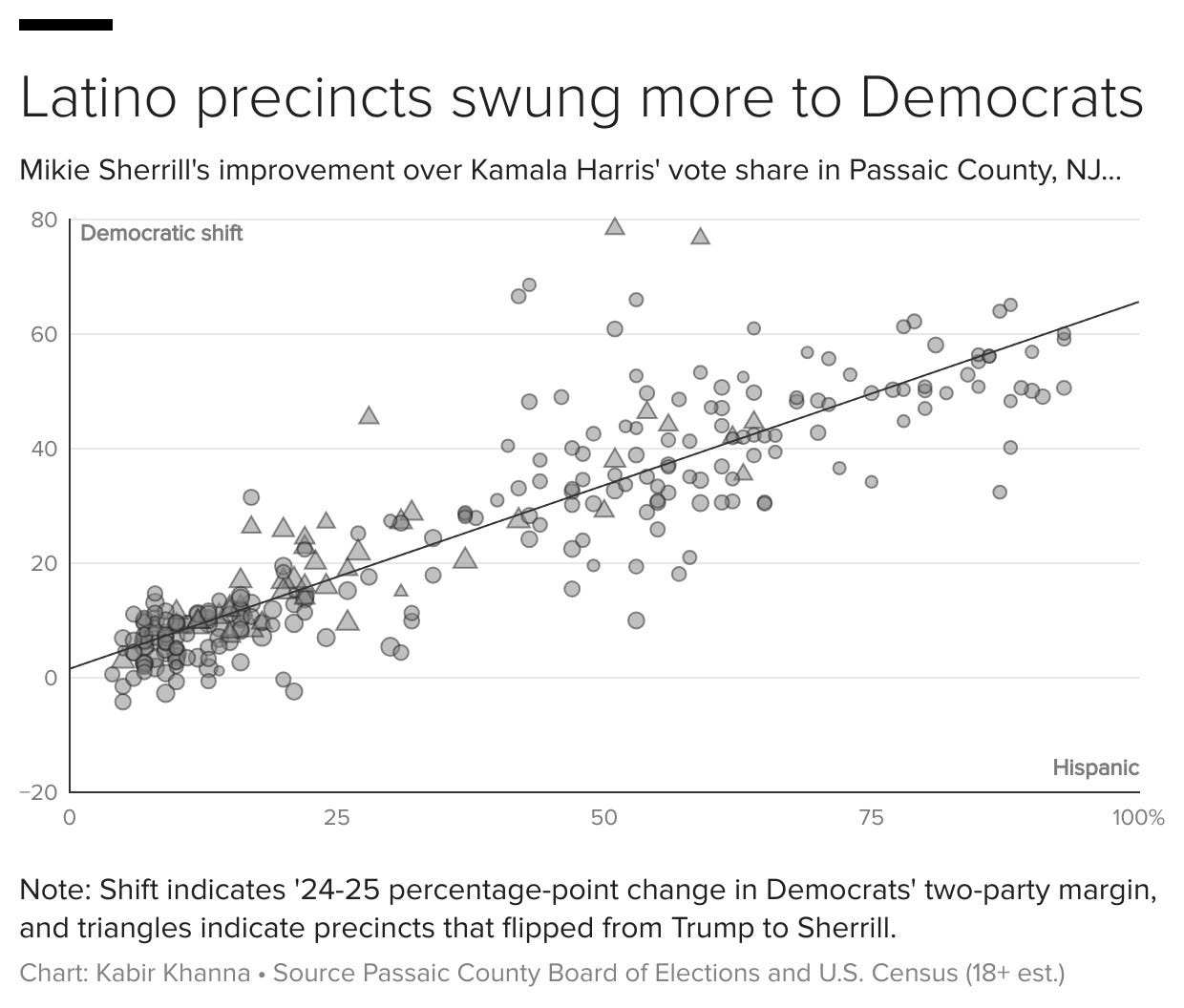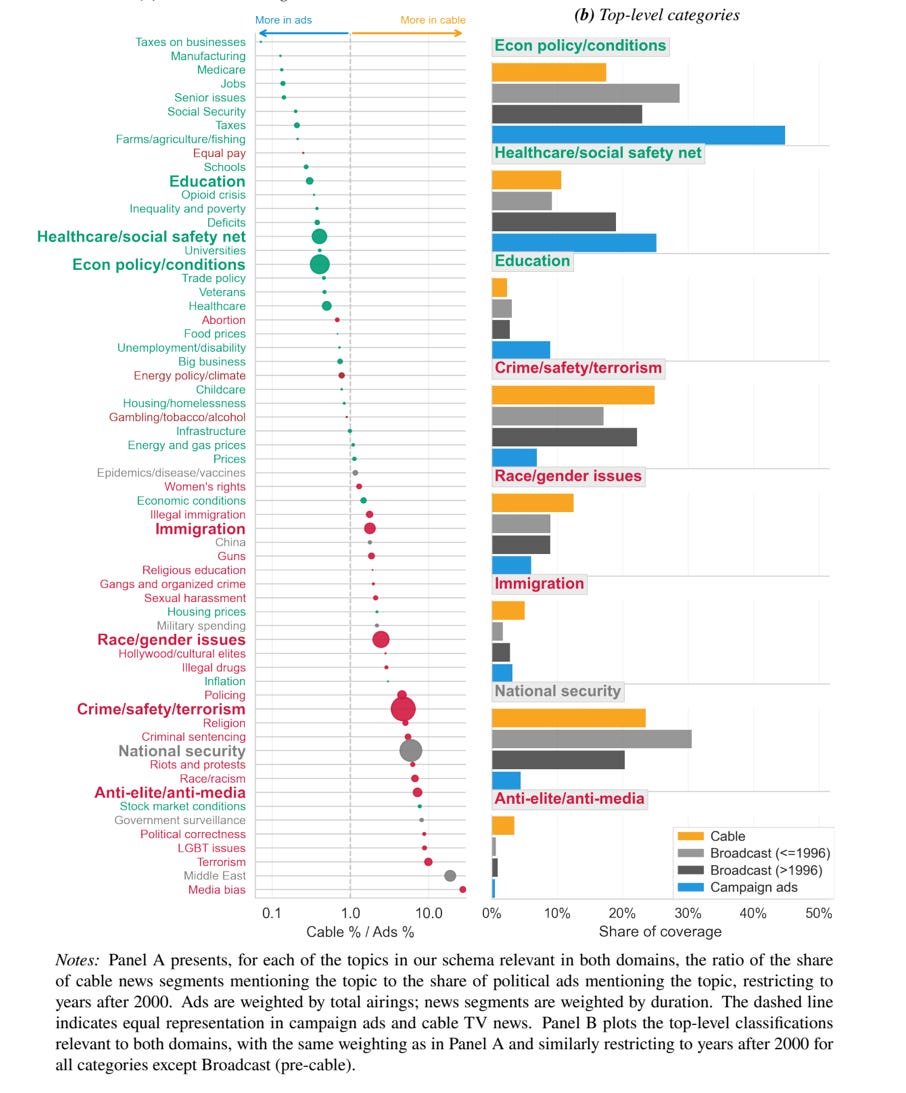The Mamdani youthquake in New York City | Weekly roundup for November 9, 2025
The Mayor-elect drove historic turnout and a historically young electorate. Plus: Democrats made inroads with Trump supporters Tuesday; The role of cable news in Trump's 2024 win; + more!
Dear readers,
It has been a very busy week here at Strength In Numbers (as you’ll see in section 2). Not only was the editorial schedule packed with content, both written and recorded (and of course, I was up all night Tuesday), but I also spent most of the day Wednesday writing questions for our November poll with Verasight. If all goes according to plan, that will come out next week (the week of the 17th), and will generate a lot of data for our conversation about what Democrats need to do to win in 2026 and 2028.
This week’s lead story is about Zohran Mamdani’s win in New York City. His victory, while unsurprising, suggests several ways Democrats can to appeal to low-engagement voters — a key problem the party has faced in the Trump era. The rest of the roundup also focuses largely on the results from Tuesday’s elections.
On deck here at SIN: I plan on finally getting around to writing my piece on social media and politics today, with the working title “The bipartisan case for Bluesky (seriously, hear me out).” The Friday post, as usual, will react to whatever is in the news.
Thank you for subscribing to Strength In Numbers! Last week was a big success for this small solo newsletter, and I’m grateful to you all for playing a key part in it.
1. The Mamdani youthquake suggests a way for Democrats to repair their brand
Driving Democrats’ big victories in the 2025 elections on Tuesday were lots of big swings. Latino-heavy precincts moved ~60 points to the Democrats since 2024. Voters from families making less than $50,000 per year also lurched left. Exit polls suggest higher-than-average movement among Asian voters and women, too.
But one chart that really caught my eye is this one, showing the percent of voters participating in New York City’s mayoral election that were less than 45 years old:
This is a youthquake. CBS News reports that:
Data from the New York City Board of Elections indicates that of the two million voters who cast ballots in person, 42% were under age 45 — a much higher share than in recent mayoral races. In 2021, just 27% of those who voted for New York City mayor were under 45.
First-time voters also made up an abnormally high 20% of the electorate on Tuesday. These new voters broke for Democratic Party and democratic socialist candidate Zohran Mamdani over former governor Andrew Cuomo by a margin of 66-30. This group was as pro-Mamdani as young voters overall, who broke 70-25 in his favor.
This data suggests Mamdani won in large part by both turning out new voters and by engaging young ones. His affordability message also helped him win; Mamdani won voters who said their family’s financial situation is “falling behind” by a margin of 59-33.
Crucially, Mamdani also won two-thirds of voters with an unfavorable view of both political parties. This is something that Donald Trump managed to do in 2016, 2020, and 2024, as well. It suggests Mamdani’s appeal is not solely ideological, but also a function of his emphasis on issues off the usual left-right axis such as corruption, affordability, and greed. Mamdani’s victory speech is a good example of how he tailored his campaign to the concerns of working and middle-class New Yorkers regardless of their ideology. He pledged an end to politics that “abandons the many and answers only to the few.”
Needless to say, if Democrats managed to make new voters 20% of the electorate in 2024, and won 60% of them, the race would not have been close. Maybe the party can learn something from Mamdani’s success in turning out new voters and engaging anti-system voters with an agenda aimed at affordability and the American Dream. That is, after all, what most voters say they want out of politics anyway.
2. What you missed at Strength In Numbers
It has been a busy week at Strength In Numbers, with a new post almost every day this week!
On Saturday, I posted the recording of a video podcast I did with Paul Krugman about the 2025 and 2026 elections (recorded on Thursday):
I recorded another conversation about the election with Ryan Lizza, formerly of POLITICO and CNN and now making a home here at Substack:
Friday’s Chart of The Week was about the large swing against Trump we saw Tuesday night, and why it suggests talk of a realignment in 2024 was premature:
On Wednesday, I posted seven data-driven takeaways from Tuesday’s elections:
On Tuesday, I posted final forecasts for the various statewide races happening across the country:
And if you missed it, here’s last week’s data roundup, about why the Democrats’ problems in the Senate are not due to progressivism, but nationalization of media and political identities:
If you’re a subscriber to Strength In Numbers, your prorated cost for each of these articles is just thirty cents. As you’re thinking about the media diet you want to create for next year’s midterms, consider a paid subscription to this Substack. Members get extra premium posts at least once a week (and, lately, more like 2-3x a week), an early look at any data products I’m developing, access to a private Discord server just for paid members, and more.
Paying members also support all the work that goes on behind the scenes to put together the SIN/Verasight poll, my state and congressional district MRP models, and all the other analyses that power my journalism.
3. Even more numbers!
Links to other articles in the political data space I discovered over the last week
Dot map of New York mayor results!
Economic pessimism among Latinos, as well as anger at Trump’s deportation agenda, is driving many in the group away from the president
Precincts in New Jersey with higher shares of Latino voters swung more toward Democrats, implying a 60-point swing among the group from 2024:
Natalie Jackson says “Republicans find themselves where Democrats were a year ago”
Nate Cohn does the math and finds Democrats won in part on Tuesday because they persuaded Trump voters to switch parties. In New Jersey, Democrats’ victory looks to be about 35% due to turnout and 65% due to persuasion. In Virginia, the percent due to turnout was probably closer to 50%.
”VICTORY! Federal district court dismisses class-action suit against pollster J. Ann Selzer”
Where we stand 10 years after the Paris Climate Accords (lots of good charts)
My interview with On The Media from WNYC on whether moderates win more elections
Visualizing the bias of single-member districts in Massachusetts
Another interview with me in The New Yorker about the gerrymandering wars and who wins/loses under certain scenarios
Interesting paper: Physical partisan proximity outweighs online ties in predicting US voting outcomes
And: Cable news coverage emphasizes social issues over economics, elevating cultural conflict and curtailing efforts by politicians to focus on kitchen-table issues
4. Polling update
The Strength In Numbers polling averages have moved to a new webpage at fiftyplusone.news, a website purely for poll-tracking that I’ve set up with my friends. Some averages, like my average of Trump’s approval rating on individual issues, remain on the data portal.
That’s it for your major political data stories this week.
Got more for next week? Email your links or add to the comments below!
Have a nice week,
Elliott













I think you can see in these victories the broad outlines of a 2026 policy agenda:
1. Achievable reforms to address affordability.
2. Anti-corruption/anti-authoritarianism.
3. On cultural issues, wide berth for candidates to do what works in their districts.
Just want to thank you for linking The Business of the Culture War. I am a veteran of both the last days of the “network era” at ABC News and the dawn of the cable news at MSNBC. While I have long felt the devolution “ruined everything” I had never thought of exactly why and how. This paper is outstanding.